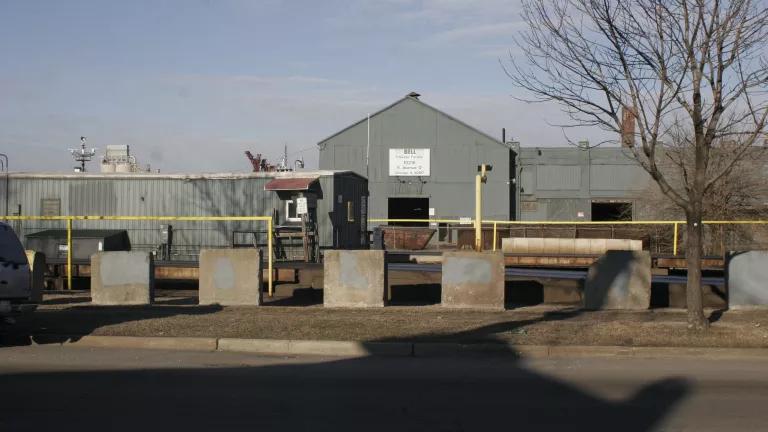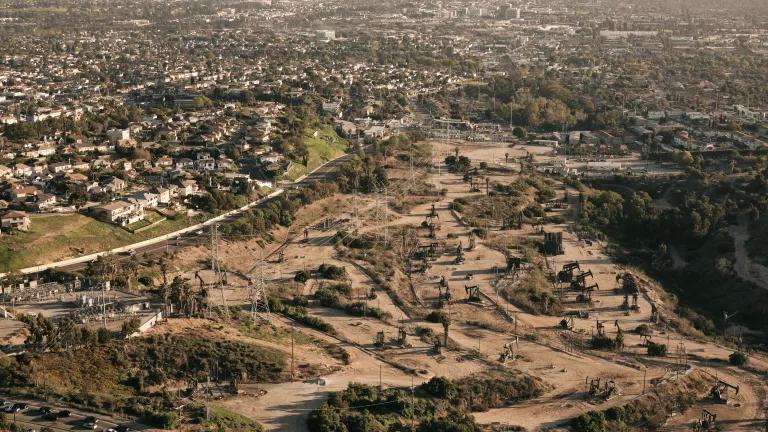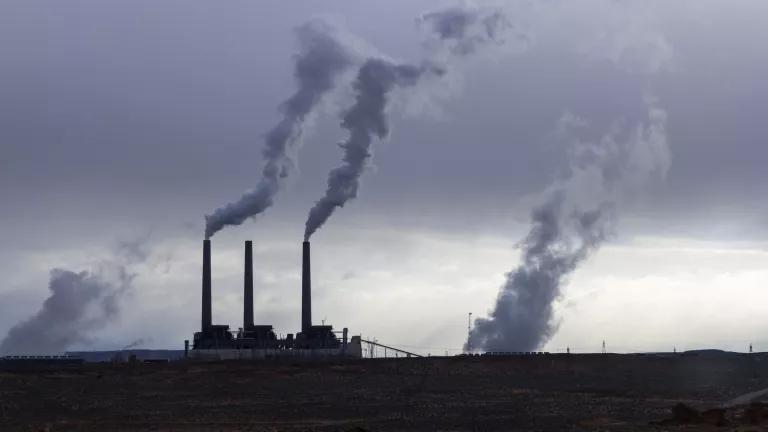NRDC and Partners Sue L.A. to Protect Communities from Port Pollution

The Port of L.A. didn’t just violate the law—it violated its commitments to millions of residents who live under the choking pollution emitted by its operations.
Earlier today, a coalition of community activists and environmental advocacy groups—including NRDC, San Pedro and Peninsula Homeowners’ Coalition, San Pedro Peninsula Homeowners United, East Yard Communities for Environmental Justice, and Coalition for Clean Air—sued the City of Los Angeles, seeking to reverse its approval of the Port of Los Angeles’s 2019 Supplemental Environmental Impact Report for the China Shipping Container Terminal. The filing of this lawsuit marks the most recent chapter in a decades-long battle between the city and public health and environmental advocates fighting for their right to breathe clean air.
A 20-year battle continues
Nearly 20 years ago, the Port of Los Angeles signed a 40-year lease with China Shipping to construct and operate a massive container shipping terminal. It did so without preparing a project-specific environmental impact review and adopting mitigation measures to offset the adverse environmental impacts of the project—requirements under the California Environmental Quality Act (CEQA). Representing ourselves and several environmental advocacy and local resident groups, NRDC took the port to court, where we obtained an injunction stopping the project until the port complied with CEQA and negotiated a ground-breaking settlement that required the port to adopt a suit of state-of-the-art—but commonsense—measures to mitigate the environmental impacts of the China Shipping Terminal.
In 2008, as required by the settlement, the port issued an Environmental Impact Report (EIR) analyzing the potential significant environmental impacts of the expansion and operation of the China Shipping Terminal. Under that EIR, the port committed to implementing a host of mitigation measures, for example, requiring all ships stopping at the terminal to utilize Alternative Maritime Power, which reduces cargo vessels’ emissions by allowing ships to plug into shoreside electric power, instead of idling their engines while at port. The EIR also established a timeline requiring the port to ensure that China Shipping replace its diesel-powered cargo-handling-equipment with cleaner technologies, including zero-emissions equipment, over the life of the project.
While local residents and environmental advocates believed the port could do more, they were optimistic that the 2008 EIR was a sign of the port’s desire to rectify its earlier errors and embrace its duty under the law to prevent environmental damage and protect the health of its surrounding communities.
These hopes, however, were short lived.
In 2008, the port began granting secret, unlawful waivers to China Shipping, which guaranteed the shipping giant would face no consequences for violating some of the 2008 EIR’s mitigation measures—exemptions the port continued to extend for many years, in secret, and in violation of the law. In 2015, the port announced its plan to prepare a new environmental review document. The port’s Notice of Preparation half-heartedly acknowledged that it failed to implement 11 of the 2008 EIR’s mitigation measures. The notice also suggested that this new environmental review document, the Supplemental EIR, was intended to gut—and in some cases eliminate—these mitigation measures, at China Shipping’s behest.
Indeed, when the port issued its Supplemental EIR for the China Shipping project in October 2019, it modified or eliminated 11 crucial air quality– and transportation-related mitigation measures under the pretext that these were technologically, operationally, and economically infeasible—ignoring the fact that 11 years prior, the port held the opposite opinion.
Understanding the 2019 Supplemental EIR’s significant adverse impacts to human health and the environment, NRDC and our partners appealed the Board of Harbor Commissioner’s approval of the Supplemental EIR to the Los Angeles city council. On August 12, 2020, after what could only be described as a performance with a predetermined outcome, the city council voted 12–1 to deny our appeal and certify the 2019 Supplemental EIR, sanctioning 20 years of broken legal commitments by the port.
And so we sued.
Impacts to the community
The Port of Los Angeles handles more than 40 percent of all containerized cargo in the West Coast and at least 17 percent of all containerized cargo nationwide. These goods arrive in containers transported by petroleum-burning heavy vessels, are offloaded from ships by diesel-powered cargo-handling equipment, and transported to local distribution centers by diesel trucks and trains. Together with its neighboring Port of Long Beach, the ports are the largest fixed sources of air pollution in the South Coast Air Basin, one of the most polluted air basins in the United States. The South Coast Air Basin is in non-attainment under the federal Clean Air Act for both PM 2.5 and ozone. Emissions from port operations significantly contribute to these designations.
Exposure to dangerous air pollutants such as smog and nitrogen oxide is known to cause and exacerbate a host of illnesses, including asthma and respiratory infections. Diesel particulate matter, emitted in massive amounts by the many ships, trucks, and diesel-powered equipment servicing the port, is a known carcinogen in California.
The neighboring communities of Wilmington, San Pedro, and Long Beach shoulder the brunt of all this, facing the region’s highest cancer risk from air pollution and suffering from some of the highest asthma rates across the state. Sensitive groups, including children and older people, face an increased risk as exposure to air pollution impairs lung function and growth in children and exacerbates chronic health conditions leading to premature death. Recent research shows, long-term exposure to NOx may be one of the most important contributors to COVID-19 fatality; even small increases in long-term exposure to particulate pollution leads to a large increase in the COVID-19 death rate.
The 2019 Supplemental EIR gives the Port of Los Angeles the green light to continue profiting from the China Shipping Terminal without having to minimize the terminal’s significant air quality impacts. More importantly, it allows the port to walk back many of the commitments upon which the original approval to operate the China Shipping Terminal was premised. This is unlawful and unprincipled.
Why we are suing the city—again
Our ask is clear: The city should comply with the law.
Today, the stakes are higher than ever. Communities across Los Angeles—and indeed, throughout California—are suffering the consequences of the days when unhindered expansion outweighed human health and environmental concerns. And while millions of Californians are currently exposed to hazardous air pollution caused by the many wildfires engulfing our state—conditions that are exacerbated by the port’s pollution—Angelenos have been deprived of clean air to breathe for decades.
The consensus is clear: Air quality in the South Coast Air Basin will not improve if the port does not clean up its act. And the deployment of zero-emissions technologies is key.
The port did not only violate the law—it violated its commitments to millions of Angelenos who live, work, study, and play under the choking pollution emitted by its operations. The port must not get away with its actions while thousands unnecessarily die each year from exposure to dangerous air pollutants.
The ultimate goal
For nearly 20 years, local residents have demanded that the port take reasonable measures to limit the environmental impacts of the China Shipping Terminal. This lawsuit is no different. We do not seek that which is “impossible to attain,” as the port suggested in its 2019 Supplemental EIR. Instead, we ask it not only to keep the promises it made in the 2008 EIR, but also to adopt additional mitigation measures that have become technologically and economically feasible since that time—such as, zero-emission cargo handle equipment and drayage trucks.
Above all, the families of San Pedro, Wilmington, and Long Beach only ask for a chance to live without fear of entirely preventable illness or death, where going outside and breathing the air does not have to be an act of courage.



